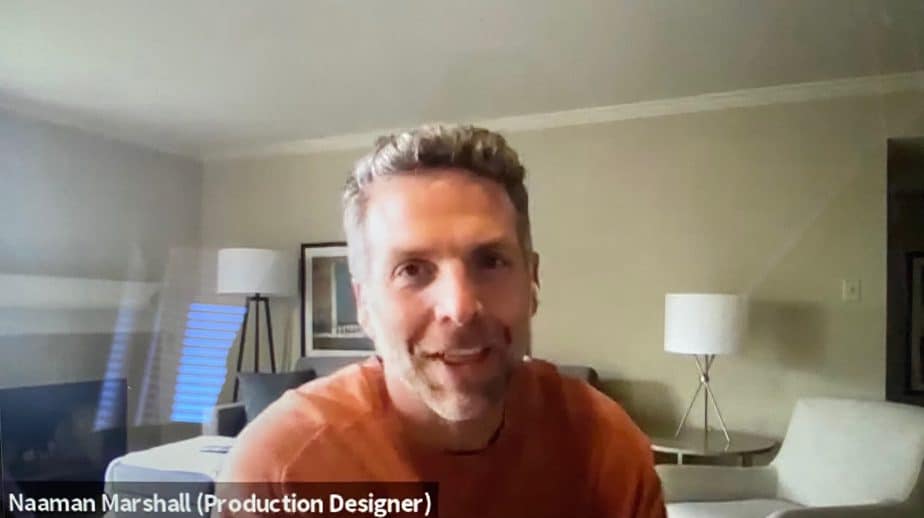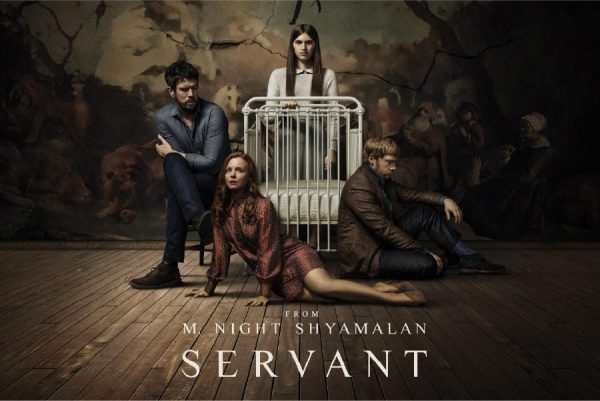When I received the invite to take part in the “Conversations with the Artisans” series with some of the crew who worked on Servant, I couldn’t sign up fast enough. Hubs and I loved season 1 and couldn’t wait to see what the second season had in store for us…especially after that S1 ending.
Before I share some of the highlights of the conversation, let’s check out the show and trailer.
Title: Servant
Season(s): Two
Format: Live Action
Episodes: 10
Platform: Apple TV+
Release Date: January 15, 2021Synopsis: From M. Night Shyamalan, Servant follows a Philadelphia couple in mourning after an unspeakable tragedy creates a rift in their marriage and opens the door for a mysterious force to enter their home.
Cast: Lauren Ambrose, Toby Kebbell, Rupert Grint, Nell Tiger Free
Writer/Creator: Tony Basgallop
Director: M. Night Shyamalan
The conversation started immediately and crew members jumped right in.

To Marshall Adams (cinematographer): what was your inspiration for this season?
It was such a collaboration with Night, it really was. We had a lot of prep time. I tend to lean towards the dark side, so that probably why I was there to begin with. In going through the show, I thought Mike did a great job with season 1 and I was just trying to keep up and keep it going.
To the cinematographer, production designer, and costume designer: how did you work together to create an overall visual aesthetic?

Naaman Marshall (production designer): in this show specifically, we all have such a tight relationship and really all of our decisions have been a combination of ideas and thoughts. The house is designed, but we’re constantly tweaking it. We’re constantly in contact with the sets coming up.

Caroline Duncan (costume designer): I will jump in and say that Naaman and the art department build this wall for every episode and for me this is very unusual in tv. It’s this complete walk through of what the sets are going to look like and not just the ambiance, but the real emotional feeling. I’ll go to that wall — and really, everyone will: props, actors, directors — and be able to get a true feeling of the mood that you’re building off of.

To Marshall Adams (cinematographer): with a different director for each episode, did you find your cinematography changing with the director or was it more cohesive?
I would say that my job description in a lot of ways is to try to bring the director’s vision to the screen. I never find it my responsibility to superimpose my ideas and designs on what they do. I try as much as possible to help them bring their vision and in that way we get a different look for every director. It’s a balance and definitely a good partnership.

To Trevor Gureckis (composer): what was the biggest difference between composing movies versus television?
definitely the time constraint. I would be writing music for an episode and they would be shooting episodes. I know the season was messed up a little bit due to Covid. We had done four or five and then everything had stopped. For the first season since it was all in one place, on one set, they would be editing it and I would get music and then the next episode would come.
For a film it’s a much longer process. It’s usually 3 to 4 months. This is a bit grueling. But at the same time, you create a long concept, a thematic concept. And that’s the show, really: it’s ten episodes of a concept. I’m doing the same musically.

To Caroline Duncan (costume designer): even though season two picks up right after season one ended, the characters have gone through a lot of changes. Can you talk about the decisions you made to show the growth?
I would start with Dorothy and how we have this backwards journey of her in season two. We have her at her most unwound and she’s in this panic and this mania about finding her child. It’s the first time that the reality of having lost her child is a reality for her. We started with her very disheveled and broken down and sad. As she takes back control of the narrative and gets Leanne back in the house and sort of commandeers what’s going on, her mania starts to bud and we start to put these large scale florals and patterns in her wardrobe to reflect that.
With Leanne, I did make this choice with Night that she — well, she gets kidnapped and she’s in her nightgown — but instead of changing her into something else, we would live with her in this nightgown for mostly the entire season. Or until the last two episodes, really. She gets buried alive in it. She gets tortured in it. All these horrible things happen to her in this one piece of clothing. We see it filthy and then she chooses to continue wearing it, so we see this degradation painted into it as this constant reminder to Dorothy of what she’s done.

To Harvey Rosenstock (editor): the story relies a lot on Dorothy’s mental state and the mystery of Leanne’s and how much control do you have on how to maintain this mystery?
I’m working on one now where Leanne is really paranoid, she’s worried something is going to happen, so her emotional state is freaked out. Whereas Dorothy is just on another planet. She’s operating as if everything’s fine even though you know she knows it’s not. There’s something in her performance that most of the directors will get and if they don’t we’ll find it. And for Sean too, who Night some time shoots in close-ups so you can really see what’s going on with him.
Basically it’s like going through all the takes, every little bit if they shoot a lot. I can always find a little nuance that was maybe not used for that scene, but the performance is constant. I think that’s what makes the show so good, the directors shoot more than enough. It’s done in a way that the performance comes first and that’s what draws the audience in.
All of the action seems to take place in the house, will there be any new locations for season 3?
Naaman Marshall (production designer): you’re right in thinking we don’t leave the house much. When I was designing the house initially, and not knowing the full four years of scripts and knowing where it was going to go, there were always little hidden spots that I would communicate with Night early on that there would be room to grow in certain areas if needed. It was never spoken of in season one. We didn’t go into the attic, but it was always a door that was there. In the new seasons, we expect to open up more spaces and let the audience find something new to explore.

What’s the best piece of advice Night has ever given you?
Naaman Marshall (production designer): night has always pushed for people to stick their nose out and push sound, push design, push editing. He kind of allows all of us to go to the extreme and he has the ability to let us know really cleverly that we’ve gone too far. So the piece of advice I’ve learned from him is that it’s easy to tone it down, but not always easy to ramp it up.
Harvey Rosenstock (editor): I agree. He’s always given me a lot of leeway in my job and then he can come in and do his job in a way that doesn’t hurt anyone’s feelings. He’s easy to talk with and when he has notes, they’re really great notes.
![]()
Huge thanks to Apple TV+ for the invite to take part in this discussion. Season 2 of Servant is out now.
Have you watched Servant? Do you plan to?





Leave a Reply